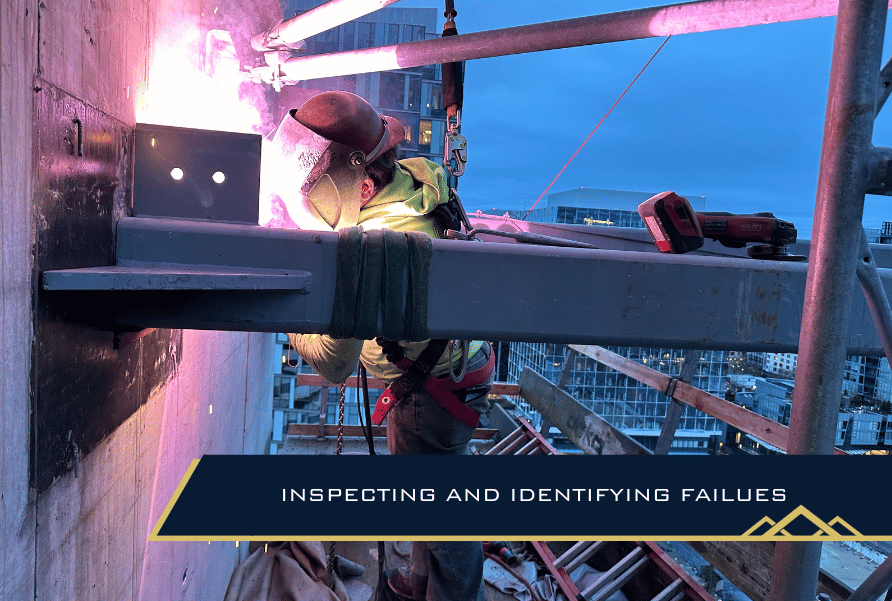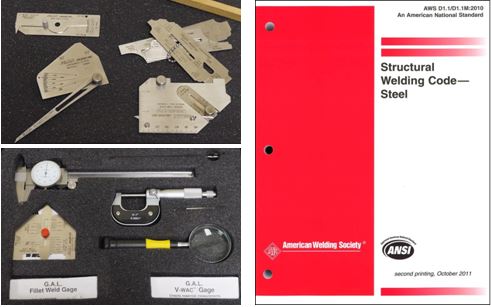Top Tips for Effective Welding Inspection in Gilbert Arizona: A Comprehensive Overview
Top Tips for Effective Welding Inspection in Gilbert Arizona: A Comprehensive Overview
Blog Article
A Comprehensive Guide to Welding Examination: Understanding Criteria, Techniques, and Ideal Practices for Quality Control

Welding inspection plays a critical function in making certain the architectural stability and safety and security of bonded parts, demanding an extensive understanding of market requirements such as those established by AWS and ASME. Different evaluation methods, consisting of aesthetic and ultrasonic screening, are utilized to discover prospective flaws that might jeopardize high quality. In addition, applying ideal methods can substantially improve operational reliability and foster trust amongst customers. As we explore these crucial elements, it comes to be obvious that the ramifications of welding evaluation extend much past compliance, welcoming a closer evaluation of exactly how these processes form market standards and techniques.
Relevance of Welding Assessment
Welding examination plays a critical role in ensuring the stability and safety and security of welded frameworks. It is a vital procedure that verifies that welds adapt predefined specifications, which is important in numerous industries, including building, automotive, and aerospace. By carrying out thorough assessments, possible defects such as fractures, incomplete blend, and porosity can be recognized early, avoiding disastrous failings that could result in mishaps or expensive fixings.
The importance of welding evaluation prolongs past plain compliance with policies; it likewise promotes depend on with stakeholders. Customers and governing bodies anticipate assurance that the structures they rely upon are constructed to endure functional stress and anxieties. Effective welding inspection practices add to long-term sturdiness and performance of the structures, inevitably leading to decreased maintenance costs.
Furthermore, welding examination promotes a culture of top quality within companies, motivating adherence to ideal techniques and continual enhancement. By integrating evaluation processes right into the welding workflow, business can boost their online reputation and develop themselves as leaders in top quality assurance. In conclusion, the significance of welding inspection depends on its capability to protect lives, ensure architectural integrity, and maintain industry criteria, making it an important facet of welding operations.
Trick Industry Specifications
Ensuring compliance with key industry requirements is essential for maintaining the high quality and security of welded structures. Numerous companies develop these requirements to advertise best practices in welding and inspection. Amongst the most acknowledged are the American Welding Culture (AWS) and the American Society of Mechanical Designers (ASME), which provide in-depth guidelines and specs for welding procedures and assessment standards.
AWS requirements, such as AWS D1.1 for architectural welding, summary needs for materials, style, and screening to ensure the stability of welds. In a similar way, ASME codes, including ASME Area IX, control the qualification of welders and welding procedures, making certain consistent high quality in commercial applications. Globally, the ISO 3834 typical emphasizes high quality demands for blend welding, offering a framework for companies to show conformity with international ideal techniques.
Compliance with these standards not only improves the integrity of bonded frameworks yet additionally minimizes risks connected with architectural failings. Adherence to market standards is typically a prerequisite for regulatory approvals and can significantly affect task specs. Inevitably, understanding and applying these vital criteria are necessary for efficient welding assessment and high quality assurance.
Examination Techniques Review
Efficient welding evaluation depends on a variety of strategies created to evaluate the quality and honesty of welds. These methods can be broadly classified into destructive and non-destructive screening (NDT) approaches. Non-destructive screening techniques, which are extensively favored in the market, permit the evaluation of welds without endangering the stability of the material.
Amongst the most generally utilized NDT techniques are aesthetic evaluation, ultrasonic screening, radiographic testing, and magnetic particle testing. Aesthetic assessment is frequently the very first step in the analysis process, making it possible for examiners to recognize surface blemishes and evaluate weld grain profiles. Ultrasonic screening employs high-frequency acoustic waves to detect interior flaws and gauge the thickness of welds. Radiographic screening involves using X-ray or gamma-ray imaging to disclose internal flaws, while magnetic particle testing works for finding surface area and near-surface interruptions in ferromagnetic materials.
Each method has its own benefits and constraints, making it vital for examiners to pick one of the most appropriate approach based on the specific demands of the job, the materials included, and the urgency of the welds being evaluated. This mindful option ensures detailed analyses and upholds safety and security and top quality criteria in welding procedures.

Common Problems and Their Ramifications
A detailed understanding of usual issues in welds is crucial for maintaining structural integrity and security in bonded building and constructions. Welding issues can dramatically endanger the mechanical properties of the joint, leading to failures that can jeopardize both workers and devices.
Typical flaws consist of porosity, which materializes as little gas pockets trapped in the weld steel, damaging the total framework. Breaking is another prevalent concern, often resulting from quick air conditioning or improper joint design, bring about anxiety concentrations that can result in tragic failures. Incomplete blend takes place when the weld steel stops working to properly bond with the base product, producing powerlessness read this post here that might result in splitting up under tons.
Other significant flaws consist of undercutting, where the weld grain deteriorates the base steel, and slag additions, which can hinder the weld's stamina. Each of these issues has particular effects; for instance, porosity can minimize ductility, while breaking straight influences tensile strength. Determining and recognizing these defects during examination is crucial for executing rehabilitative measures and making sure compliance with industry requirements, inevitably guarding the structural integrity of welded settings up.
Finest Practices for Quality Control
Executing ideal practices for quality control in welding procedures is crucial for accomplishing optimum outcomes and decreasing defects. One vital practice is the establishment of clear welding procedures that comply with sector criteria and specs. These treatments ought to include thorough instructions pertaining to product option, joint prep work, and welding strategies to guarantee consistency and top quality.
Regular training and accreditation of welding employees are likewise crucial. Skilled welders that understand the importance of quality control are more probable to create sound welds. Additionally, implementing a durable examination program, consisting of both visual and non-destructive testing (NDT), can aid recognize flaws early while doing so, enabling prompt rehabilitative actions.
Documentation plays a vital duty in quality control. find more information Keeping precise records of welding parameters, examinations, and repair services ensures traceability and liability. Additionally, using advanced modern technologies such as automated welding makers can enhance precision and lower the capacity for human mistake - Welding Inspection Gilbert Arizona.
Lastly, cultivating a society of top quality within the company encourages staff members to focus on quality in their job. By sticking to these best methods, companies can enhance the stability of their welding procedures, ultimately resulting in boosted product high quality and lowered costs connected with rework and repair services.

Verdict
In conclusion, welding assessment plays an essential role in making sure the stability and safety and security of welded structures. Adherence to key market standards, such as those established by AWS and ASME, is crucial for effective high quality assurance. Utilizing numerous examination techniques enables the identification of typical flaws, therefore mitigating potential risks. By executing finest methods, organizations can boost reliability, reduce maintenance costs, and cultivate count on among clients, ultimately adding to successful welding operations.
In addition, welding examination promotes a culture of high quality within organizations, motivating adherence to finest techniques and constant enhancement. In verdict, the importance of welding assessment lies in its ability to protect lives, ensure structural reliability, and copyright market standards, making it a vital aspect of welding operations.
Among the most identified are the American Welding Society (AWS) and the American Culture of Mechanical Engineers (ASME), which give thorough standards and specs for welding processes and examination requirements.
Inevitably, understanding and carrying out these crucial criteria are necessary for reliable welding inspection and high quality assurance.
Reliable welding my review here assessment depends on a range of methods made to assess the high quality and stability of welds. - Welding Inspection Gilbert Arizona
Report this page